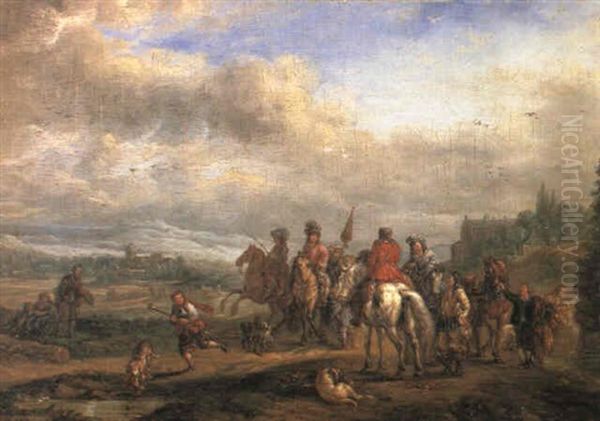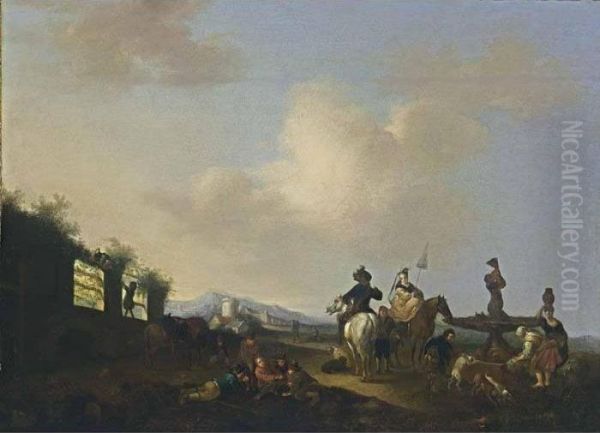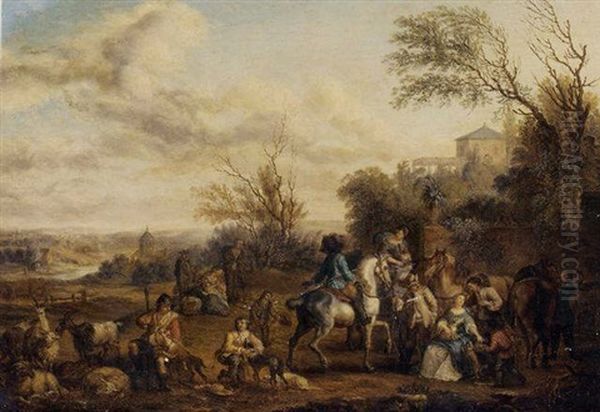Carel van Falens (1683-1733) stands as an interesting figure in the transition between the late Baroque and early Rococo periods in European art. A painter of Flemish origin, born in the artistic hub of Antwerp, Van Falens spent the majority of his productive career in Paris. There, he carved out a specific niche for himself, becoming known primarily for his elegant hunting scenes and equestrian subjects, works that catered to the tastes of the French aristocracy and bourgeoisie during the Régence and the early reign of Louis XV.
While achieving considerable recognition in his lifetime, including membership in the prestigious French Académie Royale de Peinture et de Sculpture, Van Falens's historical reputation is complex. He is celebrated for his technical skill and the charm of his compositions, yet frequently noted for his profound stylistic dependence on the earlier Dutch master, Philips Wouwerman. Understanding Van Falens requires exploring his Flemish roots, his adaptation to the Parisian art world, the specific nature of his artistic output, and his relationship with the towering legacy of Wouwerman.
From Antwerp to Paris: A Flemish Artist Abroad
Born in Antwerp in 1683, Carel van Falens emerged from one of the most significant artistic centers in Northern Europe. Antwerp, the city of Peter Paul Rubens and Anthony van Dyck, had a long and storied tradition of painting, encompassing grand history paintings, intimate genre scenes, detailed landscapes, and sophisticated portraiture. Although the peak of Antwerp's golden age had passed by the late 17th century, it remained a place with strong artistic training and traditions. The specific details of Van Falens's early training in Antwerp are not fully documented, but it is highly likely he absorbed the Flemish emphasis on meticulous detail, rich colour, and skilled rendering of textures.

At some point, likely in the early 18th century, Van Falens made the pivotal decision to move to Paris. This was not an uncommon trajectory for ambitious artists from the Low Countries. Paris was increasingly becoming the dominant cultural and artistic capital of Europe, offering opportunities for patronage, exhibition, and association with the French Royal Academy. The city possessed a vibrant art market and a sophisticated clientele eager for paintings that combined technical polish with pleasing subject matter. Van Falens arrived in a Paris where the grand manner of Louis XIV's reign was gradually giving way to the lighter, more intimate, and decorative sensibilities of the Rococo.
Artistic Style: The Enduring Influence of Philips Wouwerman
The defining characteristic of Carel van Falens's art is its deep and unwavering connection to the style of Philips Wouwerman (1619-1668). Wouwerman, a Dutch Golden Age painter from Haarlem, had specialized in landscapes incorporating horses, particularly battle scenes, hunting parties, military encampments, and stable interiors. His work was immensely popular, admired for its skillful depiction of horses in motion, its lively figures, atmospheric landscapes often bathed in a cool, silvery light, and its overall elegance and detailed execution. By the early 18th century, Wouwerman's paintings were highly sought after by collectors across Europe, including in France.
Van Falens seems to have recognized the enduring appeal of Wouwerman's style and dedicated his career to mastering and replicating it. His paintings predominantly feature the same subjects: elegant hunting parties pausing for rest, riders assembling near country inns, cavalry skirmishes, or travellers halting in picturesque landscapes. He adopted Wouwerman's compositional structures, often featuring a diagonal recession into space, a balance of figures and landscape elements, and careful attention to anecdotal detail.
Van Falens became particularly adept at capturing the specific motifs associated with Wouwerman – the lively, well-observed horses (often including Wouwerman's signature white horse), the detailed rendering of costumes and tack, the small figures engaged in various activities, and the characteristic cool tonality and delicate brushwork. His technical proficiency was considerable, allowing him to create works that closely resembled those of his chosen model in both subject and execution. This focus made his work readily identifiable and highly marketable to collectors who admired the Wouwerman style.
Recognition in Paris: The Académie Royale
Despite the derivative nature of his style, Van Falens achieved significant professional success in Paris. The culmination of this success was his acceptance into the Académie Royale de Peinture et de Sculpture in 1726. Membership in the Academy was a mark of high distinction, granting artists official recognition, access to royal commissions (though Van Falens seems to have focused more on the private market), and the right to exhibit their work at the prestigious Salon, the official art exhibition organized by the Academy.

To gain admission, artists typically submitted a "morceau de réception" or reception piece, a work demonstrating their skill in their chosen genre. While sources sometimes vary, his painting La Halte de chasses (The Hunter's Rest), now housed in the Musée du Louvre in Paris, is often cited as a prime example of the work that secured his admission. This painting showcases his characteristic Wouwerman-esque style, depicting a group of hunters and their horses pausing in a landscape, rendered with his typical attention to detail and elegant composition. His membership confirmed his status within the Parisian art establishment.
Works, Collections, and Market Presence
Carel van Falens was a productive artist, working primarily in oil on canvas or panel. His paintings were typically cabinet-sized, suitable for display in the homes of discerning collectors. The subjects remained consistent throughout his career: hunting scenes, halts of travellers, equestrian gatherings, and occasionally, military encampments. These themes resonated with an aristocratic audience that valued leisure pursuits like hunting and appreciated the refined depiction of country life.
His representative work, La Halte de chasses in the Louvre, exemplifies his style. Other works, such as those titled Falconjacht (Falcon Hunt or perhaps Equestrian Camp), have appeared on the art market, indicating the types of scenes he produced. Auction records from houses like Sotheby's in New York document the sale of his works over the years, confirming their presence in private hands and their continued circulation among collectors. For instance, records mention sales in 1995 and 1997.
An intriguing, though perhaps atypical, auction record mentions a painting titled St. Paul after his death in Malta attributed to Van Falens, sold in 1973. This subject matter falls outside his usual repertoire of hunting and equestrian scenes, raising questions about potential misattribution or a rare deviation in his oeuvre. However, the vast majority of his known and documented work firmly aligns with the Wouwerman tradition.
Beyond the Louvre, paintings by Carel van Falens can be found in various European museum collections. Institutions in cities such as Warsaw, Dresden, Saint Petersburg, and Naples are reported to hold examples of his work. His paintings were also known to be present in galleries in Berlin and Dresden during his time and later. This distribution across major European centers attests to the widespread appeal of his polished, Wouwerman-inspired paintings during the 18th century and beyond.
Contemporaries and the Parisian Art Scene

Van Falens worked in Paris during a vibrant period in French art history. The early decades of the 18th century saw the rise of the Rococo style, characterized by lightness, elegance, intimacy, and often playful or sensuous themes. Key figures of this movement were his contemporaries. Antoine Watteau (1684-1721), famous for his fêtes galantes, was active during Van Falens's early years in Paris. François Boucher (1703-1770) and Nicolas Lancret (1690-1743), both masters of charming, decorative scenes, were also part of the artistic landscape.
Another important contemporary, particularly relevant to Van Falens's specialization, was Jean-Baptiste Oudry (1686-1755). Oudry was renowned for his depictions of animals, hunting scenes, and still lifes, often working for the royal court. While Oudry developed a more robust and arguably more original style, both he and Van Falens catered to the strong market demand for hunt-related imagery. Jean-Baptiste Pater (1695-1736), a follower of Watteau, also contributed to the prevailing taste for elegant genre scenes.
The Parisian art market during this time also showed a strong appreciation for earlier Dutch and Flemish masters. Besides the highly valued Philips Wouwerman, works by artists like Rembrandt van Rijn (1606-1669), Peter Paul Rubens (1577-1640), Anthony van Dyck (1599-1641), and David Teniers the Younger (1610-1690) were actively collected and admired. Van Falens's success can be partly attributed to his ability to provide new works in a style that was already esteemed and fashionable among French collectors. He essentially offered contemporary versions of a beloved Old Master style. Other Flemish artists also found success in Paris, contributing to the cross-cultural artistic exchanges of the period, such as Nicolas Vleughels (1668-1737), who became director of the French Academy in Rome.
Critical Reception and Legacy
The assessment of Carel van Falens's contribution to art history has long been coloured by his close adherence to Philips Wouwerman. While his technical skill was generally acknowledged, critics, both during his time and later, often pointed out his lack of originality. Some contemporary or near-contemporary sources described him, perhaps harshly, as a highly skilled imitator, suggesting his work was almost deceptively close to that of Wouwerman. The term "the most adept imitating fraud" or similar criticisms appear in some historical accounts, highlighting the perception that his primary talent lay in emulation rather than innovation.
This critique, while understandable from the perspective of artistic originality, perhaps overlooks the context of the 18th-century art market. There was a significant demand for works in established, popular styles. Van Falens successfully met this demand, providing high-quality paintings that satisfied the aesthetic preferences of his patrons. He can be seen as a capable practitioner continuing a specific, highly regarded tradition, rather than a groundbreaking innovator.
His legacy is therefore somewhat limited. He does not appear to have had significant pupils who carried on his specific approach, nor did his work fundamentally alter the course of French or Flemish painting. He remains a secondary figure compared to the great innovators of the Dutch Golden Age like Wouwerman himself, or the leading lights of the French Rococo like Watteau or Boucher. However, his work serves as a testament to the enduring popularity of certain Dutch Golden Age genres and the skill with which Flemish artists could adapt to and succeed within the competitive Parisian art world.
There is little information available regarding major retrospective exhibitions dedicated solely to Carel van Falens, which further suggests his position as a competent but not pivotal figure in art history. His admission to the Académie Royale implies participation in the Salons of his time, but he has not been the subject of the kind of large-scale monographic shows accorded to more influential artists.
Conclusion
Carel van Falens represents a fascinating case study of artistic adaptation and market alignment. A talented painter trained in the Flemish tradition, he relocated to Paris and built a successful career by expertly emulating the style of Philips Wouwerman. His hunting scenes and equestrian paintings, characterized by meticulous detail, elegant figures, skillful rendering of horses, and atmospheric landscapes, found favour with French collectors and earned him prestigious recognition through membership in the Académie Royale.
While his reputation is inevitably linked to the charge of imitation and a perceived lack of originality, his work should be appreciated for its technical accomplishment and its reflection of the artistic tastes of early 18th-century Paris. He skillfully navigated the demands of the art market, providing refined and charming paintings in a highly popular style. Though overshadowed by his model, Wouwerman, and by the more innovative French Rococo masters, Carel van Falens remains a noteworthy artist whose works offer a window into the cross-cultural artistic currents and collecting preferences of his time. His paintings, found today in major museums like the Louvre and other European collections, continue to charm viewers with their elegance and detailed execution, securing his place as a skilled Flemish master of the hunt scene in Rococo Paris.